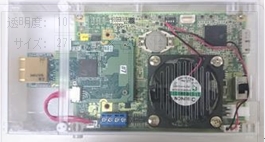 Print
Print
KDDI R&D Laboratories Develops Transmission Method That Integrates 60 GHz Band Communications and LTE
May 25, 2015
KDDI R&D Laboratories, Inc.
SAITAMA, JAPAN, May 25, 2015 — KDDI R&D Laboratories, Inc. announced today that it has developed a new communication method that transmits data using LTE together with the 60 GHz band.1 Although it is possible to deliver 60 GHz band waves over broadband of greater than 1 Gbps of capacity, until now, it has been difficult to transmit signals over long distances, reducing feasibility for use in mobile communications services. In addition, because the several Gbps capacity is greater than the current LTE speeds, the several hundred Mbps level., it has been expected that transmission speeds in fixed-line networks would also be a problem.
In response to these challenges, KDDI R&D Laboratories devised a communications method that can sufficiently utilize the high-speed capacity of the 60GHz band by making communications in this range compatible with LTE. It demonstrated success using an actual AndroidTM-equipped terminal. Expectations are high for the application of the new method to mobile communications services on high-frequency bands, for which widespread construction had been difficult.
The new communications method is one of the results of an effort at R&D of technology for advanced use of frequencies for building a radio access integrated network in the millimeter wave band, which was undertaken by the Ministry of Internal Affairs and Communications of Japan (MIC) under its Research and Development for Expansion of Radio Wave Resources.
Research Background
The surge of mobile traffic has led to insufficient frequency resources, and it has become necessary to utilize higher frequency bands. In particular, there is an enormous amount of R&D being undertaken with regard to extremely high-frequency wavebands, aiming to realize fifth-generation mobile and wireless communications systems, or 5G, which is now being pursued by countries around the world.
However, since high-frequency wavebands have a great deal of attenuation, it is difficult to transmit these waves over long distances, making coverage of wide areas infeasible. This has made use of these wavebands in mobile communications impractical. As a solution to this issue, one possibility is to consider supplemental techniques involving wideband communications such as LTE, but with TCP/IP communications being widely adopted on today’s Internet, negotiation time is required prior to starting transmission. This means that much time is needed to switch between high-frequency communications and LTE, and continuous communication is impossible.
In addition to this issue, another problem is that the communication speed that the user experiences is affected by the end-to-end connection quality. Due to the limitations in the transmission speed in the portion of the fixed line that connects the base station to the Internet, sufficient communications speed cannot be delivered.
Technical Details
To solve the above problems, KDDI R&D Laboratories has developed a communication method that enables 60GHz band communications and LTE to interoperate compatibly. The two features of this technique are as follows.
- System “prefetches” content in advance of a user’s requirements
- Uses the Content Centric Networking (CCN) technology,*2 which is now being researched as a new network architecture technology
Since control signals must be sent and received to secure communications after entering a 60GHz band, one problem has been that it was impossible to transmit data immediately upon entry into the band. In response to this, an LTE band is used to predict the 60GHz band that a user is likely to arrive at, so the desired content can be prefetched and downloaded. This enables the user to start downloads immediately upon entering the 60GHz band.
CCN is a technology based on the concept of changing the role of the network from connectivity between servers to an emphasis on the acquisition of content. Specifically, server connectivity and switching between networks, which had been a problem with the use of multiple networks, is no longer required. Given this, it becomes possible to seamlessly aggregate optimal data transmissions over the 60GHz band and LTE. Moreover, the “contents” become knowable as they are transmitted over the network, so based on this, it is a simple matter to determine the contents to be prefetched.

Results
KDDI R&D Laboratories has now designed the above-mentioned new protocol and readied it for Linux® OS and AndroidTM OS. In addition, it has confirmed that it is possible to download and play video from LTE and 60GHz that have been made compatible using a 60GHz band extremely high-frequency wave wireless prototype[1] that employs CMOS LSI[2].
In so doing, it is now possible to employ 60GHz and LTE without the user being aware of any switching. Given this, the time needed to finish downloads of video and other large-sized contents is shorter. It also is possible to offload LTE traffic to the 60GHz band, so in the future, even with a greater volume of mobile traffic, congestion over the LTE network can be avoided making network services easier to use. In the results of field trials using actual devices, download time was reduced to less than one-fifth of that required using only LTE, and it was confirmed that up to 90% of LTE traffic could potentially be offloaded to the 60GHz band.
The results of the field test are scheduled to be demonstrated at Wireless Technology Park (WTP2015), held May 27–29, 2015, at Tokyo Big Sight. In addition, KDDI R&D Laboratories plans to conduct large-scale field tests in collaboration with partner organizations, looking toward practical implementation.

60GHz band extremely high-frequency wave wireless prototype[2]
END
1: The 60GHz band
The 60GHz band is a primary frequency band which does not require licensing anywhere in the world. In Japan, the 57–66GHz frequency range is available for use.
2: Content Centric Networking (CCN)
CCN is a new protocol that is currently under discussion at the Internet Research Task Force (IRTF) as an Internet protocol. As opposed to conventional IP that aims to link servers, CCN is based on the concept of aiming to deliver contents, and to build and rebuild networks.
[1] Y. Asakura, et al., “Prototype of 3-Gb/s 60-GHz millimeter-wave-based wireless file-transfer system,” Proceedings of 2013 URSI International Symposium on Electromagnetic Theory (EMTS), pp. 207-210, May 2013.
[2] Kenichi Okada, et al., “Full Four-Channel 6.3-Gb/s 60-GHz CMOS Transceiver with Low-Power Analog and Digital Baseband Circuitry,” IEEE Journal of Solid-State Circuits (JSSC), Vol. 48, No. 1, pp.46-65, Jan. 2013.
*Android is a trademark or a registered trademark of Google Inc.
*Linux is a registered trademark or trademark of Linus Torvalds in Japan and other countries.
※The information contained in the articles is current at the time of publication.Products, service fees, service content and specifications, contact information, and other details are subject to change without notice.